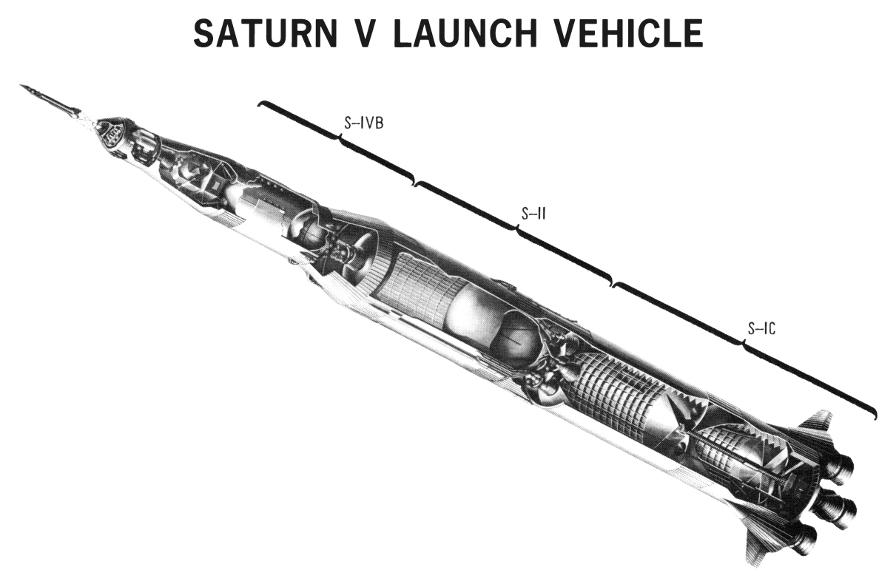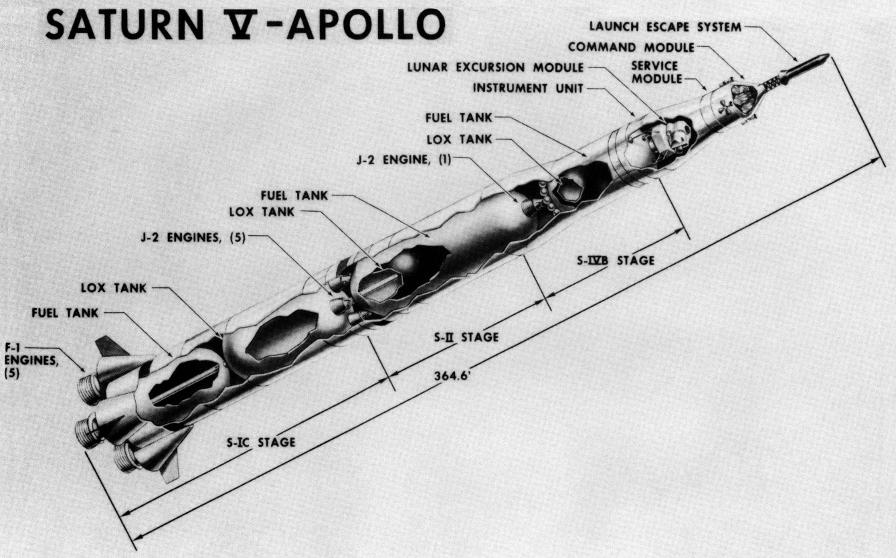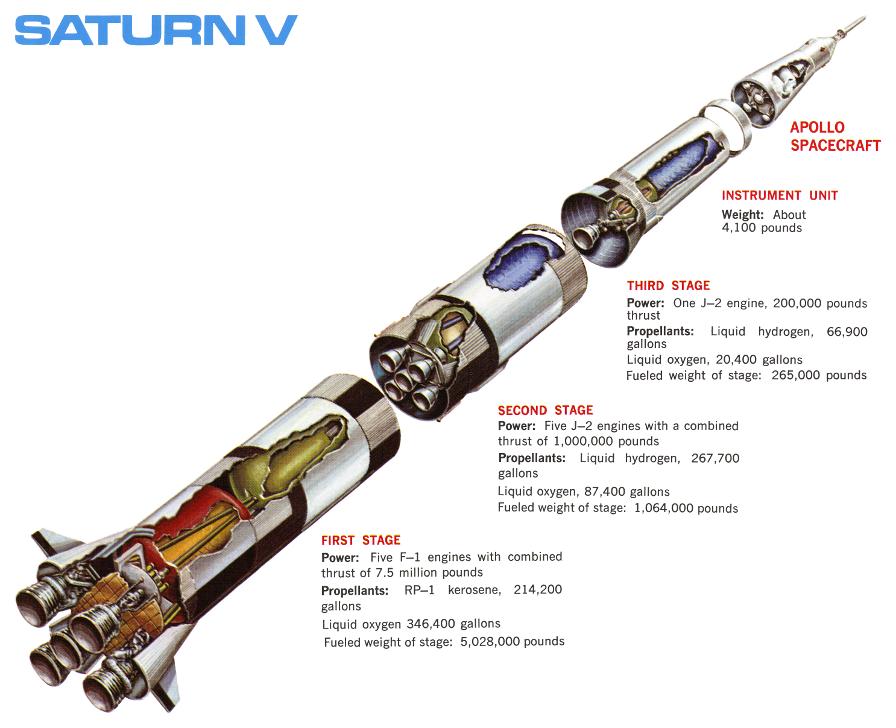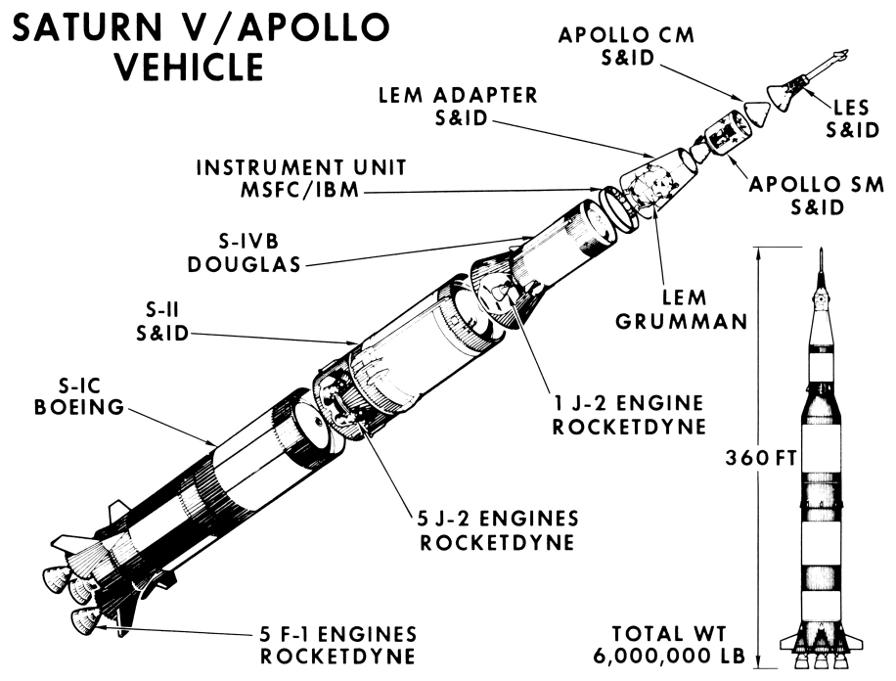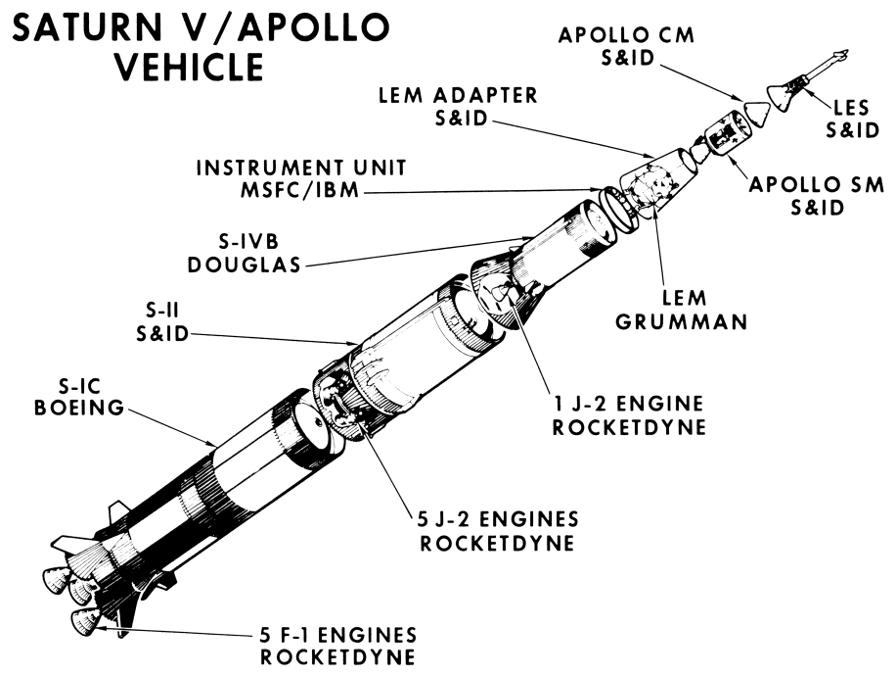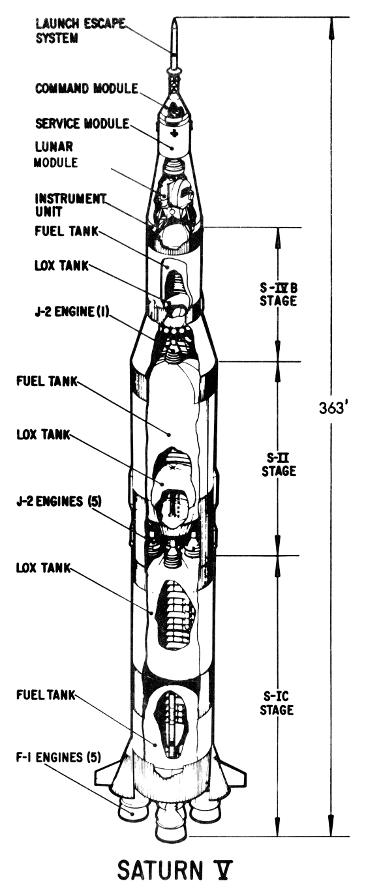General Saturn V Diagrams
I come across many Saturn V diagrams which, while interesting, are not so interesting that they necessarily merit their own separate page. I have created this page as a repository for such diagrams.
Saturn V Launch Vehicle
Here is a very early Saturn V diagram; note the of the spacecraft-lunar module adapter (SLA), which has a shape more commonly associated with a Saturn I (shorter conical section with a cylindrical section on top):
Click image for a 1717x2714 pixel version of this image in a new window.
From page 11 (p. 20 in the PDF) of the Apollo
Mission SA-501 Preliminary Mission Profile.
Extraction and cleanup by heroicrelics.
The station numbers are at right. Marshall Space Flight Center station numbers are in inches and are defined such that station 100 is the gimbal plane of the engines. This scheme seems to have started with the Jupiter missile (the first ABMA missile with an engine with gimbal capability; the Jupiter's S-3D engine was 100 inches tall from the exit plane to the gimbal plane) and continued on up to the Saturn V. This leads to the somewhat unusual need, in the case of the much-larger F-1 engine, for negative station numbers.
In this diagram, the Saturn V is 4,318 inches (359 feet 10 inches), tall; the non-standard SLA no doubt contributes to the short stature of the rocket in this diagram.
Somewhat oddly, this diagram representing an early Saturn V configuration appeared in an SA-501 (Apollo 4) document, published in February 1965, which is far too late to depict such a SLA.
Here's a diagram which identifies each of the stages of the Saturn V launch vehicle:
Click image for a 4844x3176 pixel version of this image in a new window.
Adapted from page 26 of the S-IVB Saturn High Energy Upper Stage and its
Development (Douglas Paper No. 4040), located in the Saturn V
collection, Dept. of
Archives/Special Collections, M. Louis Salmon Library, University of
Alabama in Huntsville, which also makes this document
available electronically.
Scan and adaptation by heroicrelics.
A similar diagram, with the stages and major stage components called out. The height of the launch vehicle is quoted at 364.6 feet:
Click image for a 5356x3334 pixel version of this image in a new window.
From Saturn V Booster - The F-1 Engine by D.E. Aldrich. Located
in the Saturn V Collection, Dept.
of Archives/Special Collections, M. Louis Salmon Library, University of
Alabama in Huntsville.
Scan and cleanup by heroicrelics.
This one provides additional information about each stage:
Click image for a 5945x4830 pixel version of this image in a new window.
Adapted from my NASA Facts 33 Saturn V
Poster.
Scan and adaptation by heroicrelics.
| First Stage | |
|---|---|
| Power: | Five F-1 engines with combined thrust of 7.5 million pounds |
| Propellants: |
|
| Second Stage | |
| Power: | Five J-2 engines with combined thrust of 1,000,000 pounds |
| Propellants: |
|
| Third Stage | |
| Power: | One J-2 engine, 200,000 pounds thrust |
| Propellants: |
|
| Instrument Unit | |
| Weight: | About 4,100 pounds |
| Apollo Spacecraft | |
Saturn V/Apollo Vehicle
I have two versions of this diagram, which shows each stage, their major components, and their respective manufacturers, one diagram with an inset showing the complete vehicle and one without the inset.
Click image for a 3664x2785 pixel version of this image in a new window.
From the second unnumbered page of the F-1 Engine Familiarization
Training Manual, located in the archives of the U.S.
Space & Rocket Center. Also available from University
of Alabama at Huntsville's USSRC Archive [direct link to 16.8M PDF
file].
Scan and cleanup by heroicrelics.
The stages, components, and manufacturers called out include
- LES - S&ID [heroicrelics: the Space and Information Systems Division of North American Rockwell]
- Apollo CM - S&ID
- Apollo SM - S&ID
- LEM Adapter - S&ID
- LEM - Grumman
- Instrument Unit - MSFC/IBM
- S-IVB - Douglas
- 1 J-2 Engine - Rocketdyne
- S-II - S&ID
- 5 J-2 Engines - Rocketdyne
- S-IC - Boeing
- 5 F-1 Engines - Rocketdyne
The inset notes that the Saturn V was 360 feet tall and had a total weight of 6,000,000 pounds.
No one seems to know the exact height of the Saturn V, as I've seen 360, 363, and 364.6 feet cited as its height. In reality, its height probably varied, as I imagine that weight of the propellants and the extreme cold of of its cryogenic propellants may have caused it to contract slightly. The difference between 360 and 364.6 feet is about 1.5%.
Click image for a 3664x2763 pixel version of this image in a new window.
From the second unnumbered page of the F-1 Engine Familiarization
Training Manual, located in the archives of the U.S.
Space & Rocket Center. Also available from University
of Alabama at Huntsville's USSRC Archive [direct link to 16.8M PDF
file].
Scan and cleanup by heroicrelics.
Saturn V (SA-501/Apollo 4)
Click image for a 2245x5498 pixel version of this image in a new
window.
Adapted from page 6A of the Apollo 4 Press Kit. Located in the
Kramer Collection, Dept. of
Archives/Special Collections, M. Louis Salmon Library, University of
Alabama in Huntsville, which also makes this document
available electronically.
Scan, clean-up, and adaptaion by heroicrelics.
This diagram is from the Apollo 4 Press Kit (Apollo 4).
The stages and components called out include
- Launch Escape System
- Command Module
- Service Module
- Lunar Module
- Instrument Unit
-
S-IVB Stage
- Fuel Tank
- LOX Tank
- J-2 Engine (1)
-
S-II Stage
- Fuel Tank
- LOX Tank
- J-2 Engines (5)
-
S-IC Stage
- LOX Tank
- Fuel Tank
- F-1 Engines (5)
It's somewhat odd that a Lunar Module is depicted, as Apollo 4 flew without an actual Lunar Module; the LM did not fly until Apollo 5 (although Apollo 4 did carry a Lunar Module Test Article, LTA-10R; do a "Find in page" for "10R"; a full-res version of the LTA-10R photo can be had by right-clicking the photo and doing an "Open image in new tab").
This diagram identifies the height of the Saturn V as 363 feet, but I noticed that the “363'” is in a different font than the other call-outs. I later found an identical diagram from 1965 which cites an overall vehicle height of “~364.6'” (with this height appearing in the same font as the other captions).
Saturn V Stages (SA-509/Apollo 14)
Driving home my point about no one knowing the exact height of a Saturn V, we have this diagram, of SA-509 (Apollo 14), which shows a height of 363 feet. To add insult to injury, the gross weight is 6,423,754 pounds, well over the 6,000,000 pounds shown above. (Of course, as the program progressed, the Apollo spacecraft grew in weight, and the engines of the various stages were uprated slightly to compensate.)
This diagram merely notes the vehicle's height as 363 feet, the pre-launch launch vehicle gross weight as 6,423,754 pounds, and the following vehicle components
- IU
- S-IVB Stage
- S-II Stage
- S-IC Stage
Click image for a 1153x4068 pixel version of this image in a new
window.
From page 1-6 of the Saturn V Flight Manual, SA-509
(MSFC-MAN-509). Located in the Mauldin Collection, Dept. of Archives/Special
Collections, M. Louis Salmon Library, University of Alabama in
Huntsville.
Scan and cleanup by heroicrelics.
Saturn V (SA-510/Apollo 15)
Click image for a 1256x6265 pixel version of this image in a new
window.
From the front cover of the Saturn V Flight Manual, SA-510
(MSFC-MAN-510). Located in the Mauldin Collection, Dept. of Archives/Special
Collections, M. Louis Salmon Library, University of Alabama in
Huntsville.
Scan and reconstruction by heroicrelics.
This diagram is from the cover of the Saturn V Flight Manual, SA-510 (MSFC-MAN-510) (Apollo 15).
Visually, SA-510 through SA-512 are identical to each other but distinguished from earlier launch vehicles by the fact the four ullage motors were removed from S-II interstage. The resultant weight savings helped allow an increase in payload weight (recall that the weight of the Apollo spacecraft had grown substantially starting with Apollo 15, the first of “J missions”: it now carried both additional supplies to support three lunar EVAs as well as the first Lunar Roving Vehicle or LRV).
On SA-510, the S-IC stage also deleted four of the eight retromotors (which, installed beneath the engine fairings, are not visible in this diagram).
Analysis and previous flight experience had shown that adequate separation distance between the S-IC and S-II stages and adequate propellant seating in the S-II stage could be achieved with the deletion of these motors (although the coast period between S-IC engine cut-off and the S-II engine start command was extended by one second, to ensure adequate separate between the two stages).
As it turned out, separation distance on SA-510 was less than predicted and additional analysis showed that failure of one retromotor would fail to provide the desired separation distance or, in the extreme case, even allow recontact of the stages. SA-511 and subsequent returned to using eight retromotors on the S-IC.
Saturn V Launch Vehicle
One of the odder diagrams I've come across is this "headless" Saturn V. Of course, the launch vehicles and spacecraft were the responsibilities of different, often-competing centers (Marshall Space Flight Center for the rockets and the Manned Spacecraft Center—later Johnson Space Center— for the spacecraft). One might expect this to be from a MSFC-produced document, emphasizing that it really didn't matter what one launched atop a Saturn V, but this is actually from an Apollo Spacecraft News Reference, presumably produced under the direction of the MSC.
This diagram merely notes the following vehicle components
- Instrument Unit
- Third Stage
- Second Stage
- First Stage
Click image for a 1458x5458 pixel version of this image in a new
window.
Adapted from page 8 of an undated Apollo Spacecraft News
Reference (this particular copy appears to have been published
sometime after February 26, 1966 [the launch of AS-201] but before July 5,
1966 [the launch of AS-203; recall that AS-203 was launched before
AS-202]). Located in the Saturn V Collection, Dept. of Archives/Special
Collections, M. Louis Salmon Library, University of Alabama in
Huntsville. (A later News Reference is available
electronically from NASA, and a largely similar diagram appears on page
11 of the document (page 14 in the PDF.)
Scan, cleanup, and adaptation by heroicrelics.


